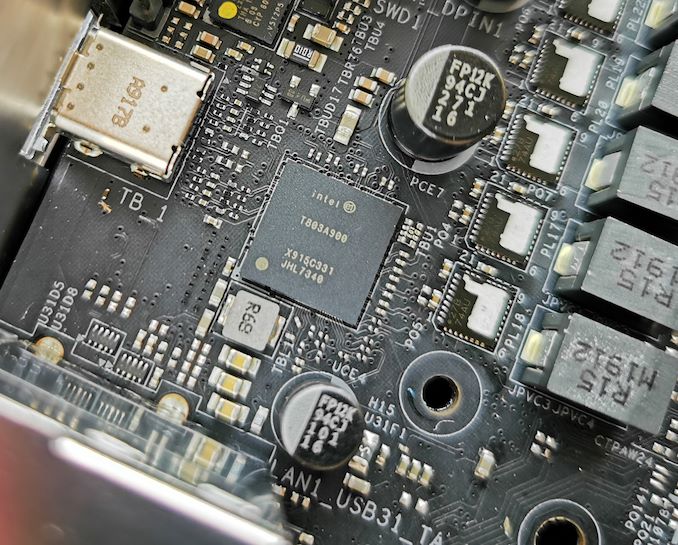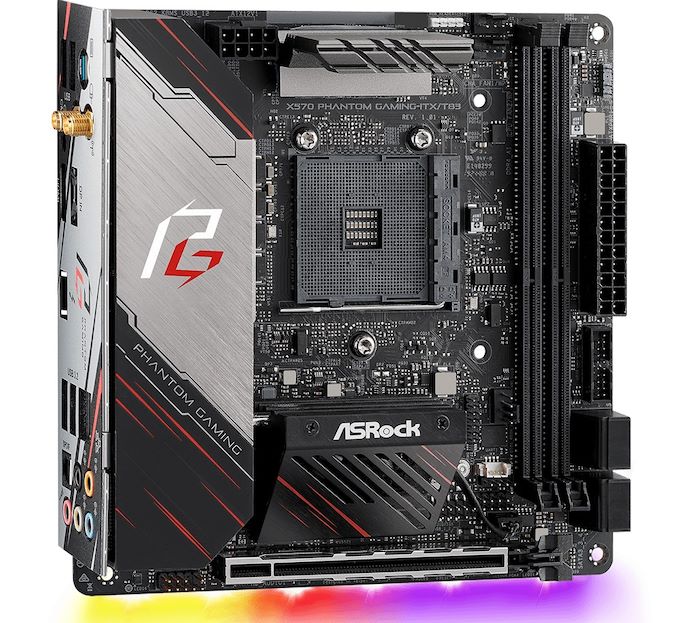AMD + ITX + TB3? It's the ASRock X570 Phantom Gaming-ITX/TB3 Motherboard Review
by Gavin Bonshor on October 9, 2019 12:00 PM ESTASRock X570 Phantom Gaming-ITX/TB3 Conclusion
The ASRock X570 Phantom Gaming-ITX/TB3 ($240) is one of just three mini-ITX motherboards across three different vendors on the X570 chipset. This makes it an interesting space for the vendors to get everything right as the GIGABYTE X570 I Aorus Pro WIFI ($220) and the ASUS ROG Strix X570-I Gaming ($299) are the only other two models to truly occupy this ITX space. Each has its own take on mini-ITX on X570, but the standout board on paper is almost certainly the ASRock X570 Phantom Gaming-ITX/TB3; not just based on features, but the combination of features for the price.
One of the primary features which sets the Phantom Gaming-ITX/TB3 apart from the competition is the inclusion of an Intel JHL7340 Thunderbolt 3 controller. This adds a single Type-C port on the rear panel, as well as a DisplayPort 1.4 input for users looking to drive multiple displays with resolutions of up to 4K from a discrete graphics card. On top of this is a Realtek ALC1220 HD audio codec which powers both the rear panel audio connections and the front panel audio header.
Also on the rear panel is an HDMI 2.0 video output for users of Ryzen's APUs, two antenna ports for the Intel AX200 802.11ax wireless interface, and just four USB 3.1 G1 Type-A ports. Aside from the four Type-A on the rear panel, users can expand this through the USB 3.1 G1 and USB 2.0 headers with each offering support up to two ports. For reference, the GIGABYTE X570 I Aorus Pro WIFI has five Type-A ports on the rear panel and doesn't include Thunderbolt 3 connectivity.
The GIGABYTE X570 I Aorus Pro WIFI is slightly cheaper but trades the Thunderbolt 3 for an extra M.2 slot. The main caveat of the single PCIe 4.0 x4 M.2 slot on the ASRock board is that it's located on the rear of the PCB meaning users with NVMe drives could experience some throttling under heavy loads, and the best approach to take would be to ensure adequate passive cooling for the rear of the board. Users looking to use SATA will need to use the four SATA ports available in the bottom right-hand corner of the board. With the board being mini-ITX, there's no scope to add additional M.2 slots with add-on cards like there is on ATX models. Memory support is very good with support for up to DDR4-4533 and up to 64 GB of total capacity. AMD Ryzen 3000's sweet spot for memory is DDR4-3600, so maximizing performance isn't too much of a concern with the insanely fast DDR4 kits, but ASRock does give users the option if they wish to do so.

ASRock loves adding Thunderbolt 3 capability
The performance of the ASRock X570 Phantom Gaming-ITX/TB3 is highly competitive and shines in the two areas most ASRock models we've seen of late generally do; POST time and out of the box DPC latency performance. Overall performance in our computational benchmarks was average with some good showing in benchmarks such as 3DPM but lower than usual results in Blender. Our overclocking performance testing proved that the ASRock X570 Phantom Gaming-ITX/TB3 is efficient in terms of load CPU VCore with the default LLC profile with good VDroop control and under volting where it's needed. Even though there are no overclocking presets for the CPU, the Eco mode which stated 45 W as opposed to our Ryzen 7 3700X's 65 W TDP proved very fruitful for users looking to build a slightly lower-powered small form factor system; Eco mode performance was on par with 3.8 GHz performance in our manual testing.
Turn the Lights Off, Carry Me Home

ASRock Phantom Gaming X570-ITX/TB3
For users looking to build a small form factor system using Ryzen 3000 with Thunderbolt 3 devices, the ASRock X570 Phantom Gaming-ITX/TB3 is a no brainer at just $240.The ASRock X570 Phantom Gaming-ITX/TB3 in our opinion continues ASRock's recent trend of providing formidable mini-ITX solutions. We can't wait to fit one with a 16-core Ryzen 9 3950X, which is expected to hit shelves in November.











64 Comments
View All Comments
TheinsanegamerN - Wednesday, October 9, 2019 - link
Except there is no expansion do do so...oops.This is mini ITX. This stuff NEEDS to be on the board. You can tjust add it, there is nowhere to do so!
Death666Angel - Thursday, October 10, 2019 - link
May I introduce you to the concept of USB hubs?Valantar - Wednesday, October 9, 2019 - link
Leaving the x4 m.2 PCIe link off the CPU on the table is bordering on criminal. Sure, the board is packed nonetheless, but when every single competing board has two m.2 slots, this is a no-go. Sure, TB3 would be nice, but to be realistic the only thing it would be used for would be TB3 networking when needing to do quick file transfers to a laptop. Not worth the loss of a second m.2 slot by a long shot. And sure, I could get a TB3 SSD case - and drive up the price of that second drive by 2-3x. No thank you. I'll likely go for the Gigabyte or the Strix.Valantar - Wednesday, October 9, 2019 - link
Worth adding: a legitimate use case for this would be connecting the upcoming Apple monitor. Not many SFF desktop PCs capable of that. But will that even work with non-Apple hardware?Calamarian - Thursday, April 16, 2020 - link
As far as I know no WinPC thunderbolt 3 connection would work as apple "over-clocks" it's TB3 connections to run the Apple display... :(TheinsanegamerN - Wednesday, October 9, 2019 - link
Could it be lack of trace room? Socket AM4 is bigger, leaving less space to run traces, and you already have a LOT going through a small space.DigitalFreak - Thursday, October 10, 2019 - link
While I agree with you, I'm guessing they did it because using the x4 link on the CPU for NVMe wouldn't allow the M.2 slot to support M.2 SATA drives as well. That said, they should have run the Thunderbolt controller off that x4 link if it wasn't being used.TheinsanegamerN - Wednesday, October 9, 2019 - link
Why dont they put this level of effort into micro ATX boards?DanNeely - Wednesday, October 9, 2019 - link
Because sales have imploded. The people who care about size have left for miniITX as the relevance of SLI/XFire has vanished and the price/performance penalty for the smaller size has withered away. The part of the market that doesn't care is sticking with full ATX because why not,their case holds a full size board, they might need one of the extra connectors someday, and besides the more spread out layout makes getting all the connectors in easier.
Pushing higher PCIe standards more than a few cm is going to get increasingly expensive; which is why AMD hasn't offered a 550 chipset with PCIe4 yet. Cost reasons might push mainstream PCIe4 boards out of the full ATX range. PCIe5 is much worse; to the extent that it might not become a consumer standard at all; it's looking like just reaching from the CPU to the top PCIe slot or chipset will either need expensive redriver chips or PCBs that cost a few hundred dollars for a full sized board. Assuming it happens at all, I suspect that will put a lot of price pressure towards a revival for micro ATX.
jeremyshaw - Wednesday, October 9, 2019 - link
I feel they'll just have the top slot be PCIe 4/5, then all of the other slots at PCIe 3 or even 2. Depending on chipset placement, it may not even be viable for the chipset to have PCIe5.